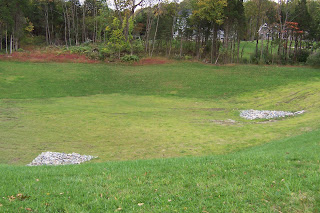Papyrus Daydream


For readers who may have wondered what ever happened to the papyrus that I overwintered indoors (see http://loisdevries.blogspot.com/2007/12/papyrus-prolonged.html), it’s alive and thriving again in its summer spot, next to the Ligularia. Having this plant in my garden is a personal eccentricity. There is no Egyptian theme, no water theme, no exotic plant collection.
I’ve always been fascinated by Ancient Egypt and visited there in 1986. The papyrus is, of course, an iconic symbol that is seen everywhere in Egypt, in temples, tombs, and on the towels of modern hotels. I brought home and framed a number of souvenir paintings made of papyrus. Most of them depict papyrus plants, either as the focal point, or in the background. There’s just something about the shape and texture of papyrus’ ethereal mopheads that appeals to me.
The plant itself turns out to be a surprisingly easy keeper. All it seems to want is continuously wet feet, sun, and a little plant food from time to time. Now that my Ironweed, Meadow Rue, and Wild Bergamot have matured, the six-foot tall spires of the Papyrus don’t look quite so out of place.
Papyrus spreads horizontally by runners and can become invasive, especially in warmer climates, so you may want to keep it in a pot, or a trench lined with metal. Mine stays in its same pot year-round. Outdoors, the pot is hidden by Ligularia leaves and some flowering weeds; indoors, it slips inside a seamless copper cache pot.
Do you have a favorite plant that just doesn’t seem to go with the rest of your garden? Here are two different ways you can solve this problem. The easiest one is to buy an exceptionally nice container worthy of the special meaning that plant holds for you. This portability allows you to accommodate the plant’s cultural needs regardless of the requirements of the rest of the garden while, at the same time, making it a focal point.
Another approach is to create a colony of your favorite plant and surround it with something neutral, such as ferns, boxwood, or a groundcover. This creates a buffer that provides a visual transition with its own interesting color and texture, but doesn’t compete with either the special plant colony or the rest of the garden.
A garden that satisfies your dreams must include those plants, no matter how weird or unconventional, that hold a special appeal for you.


